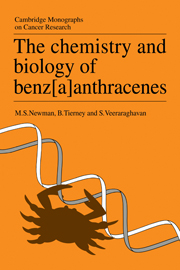Book contents
- Frontmatter
- Contents
- Authors' preface
- Abbreviations employed in this book
- Part 1 CHEMISTRY
- 1 Synthetic routes from benzenes and naphthalenes
- 2 Synthetic routes from anthracenes (A-ring formation)
- 3 Synthetic routes from phenanthrenes (D-ring formation)
- 4 Synthetic Diels–Alder routes to rings B and C
- 5 Miscellaneous synthetic routes
- 6 Tables
- 7 References to Part 1
- Part 2 BIOLOGY
- Index to Parts 1 and 2
3 - Synthetic routes from phenanthrenes (D-ring formation)
Published online by Cambridge University Press: 07 September 2010
- Frontmatter
- Contents
- Authors' preface
- Abbreviations employed in this book
- Part 1 CHEMISTRY
- 1 Synthetic routes from benzenes and naphthalenes
- 2 Synthetic routes from anthracenes (A-ring formation)
- 3 Synthetic routes from phenanthrenes (D-ring formation)
- 4 Synthetic Diels–Alder routes to rings B and C
- 5 Miscellaneous synthetic routes
- 6 Tables
- 7 References to Part 1
- Part 2 BIOLOGY
- Index to Parts 1 and 2
Summary
Friedel–Crafts reactions
The four carbons needed to convert phenanthrenes into BAs have been introduced by succinoylation, which takes place at the 3-position of phenanthrene and at the 2-position of 9,10-dihydrophenan threne, Scheme XXI. With succinic anhydride 153 was produced and with α-methylsuccinic anhydride 156 was formed. Reduction, usually by the Clemmensen route afforded the acids, 154 and 157, which on ring closure yielded the 8-keto-8,9,10,11-tetrahydroBAs 155 (Haworth and Mavin, 1933), and 158 (Cook and Haslewood, 1934), respectively. Although ring closures to ketones 155 and 158 are most often effected by conversion of acids to acid chlorides followed by AlCl3 or SnCl4 promoted cyclizations, the use of trifluoromethanesulphonic acid anhydride (Hulin and Koreeda, 1984), and methanesulphonic acid (Premasagar et al., 1981), for such closures has also been reported. By reduction of 155 and aromatization, BA was obtained. Similarly 158 yielded 9-MBA and by reaction of 158 with methylmagnesium iodide followed by aromatization, 8,9-DMBA was produced. The latter hydrocarbon was of interest in establishing the structure of methylcholanthrene (Cook and Haslewood, 1934). The condensation of succinic anhydride with 3-methylphenanthrene afforded β[6-(3-methylphenanthroyl)]-propionic acid, 159, from which 2-MBA was synthesized by conventional steps (Bachmann and Cortes, 1943). Similar reaction of succinic anhydride with 9,10-dihydrophenanthrene yielded β-(9,10-dihydro-2-phenanthroyl)propionic acid, 160, which was converted into BA by reduction of the keto group, cyclization to 11-keto-5,6,8,9,10,11-hexahydroBA, 161, further reduction to 5,6,8,9,10,11-hexahydroBA and aromatization by heating with selenium (Burger and Mosettig, 1937).
- Type
- Chapter
- Information
- The Chemistry and Biology of Benz[a]anthracenes , pp. 27 - 30Publisher: Cambridge University PressPrint publication year: 1988



